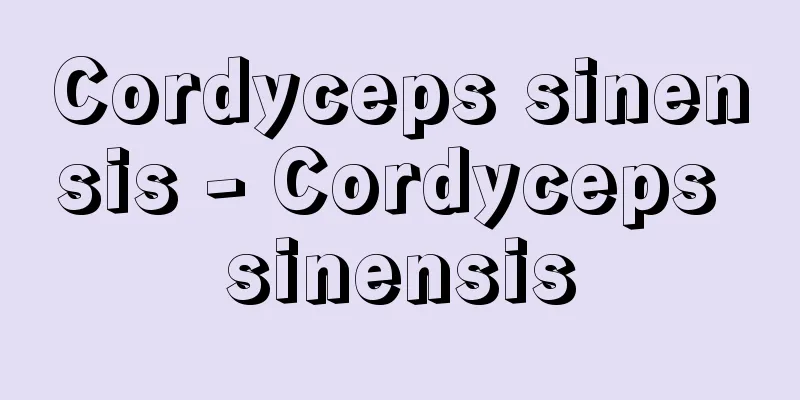Cordyceps sinensis - Cordyceps sinensis

|
This word has three meanings, so I will explain each one in order. (1) A herbal medicine made by taking the club-shaped fruiting bodies (mushrooms) that grow from the heads of moth larvae of the Lepidoptera, Noctuidae family, found in Sichuan, Yunnan, Tibet, and other areas in China, together with the moth body, and drying them. It was prized as an aphrodisiac for eternal youth and longevity. It is said to replenish essence, increase marrow, maintain the lungs, increase the kidneys, stop blood, turn phlegm, and stop coughing. This mushroom is Cordyceps sinensis, a species of the Cordyceps genus. In summer, germ tubes that grow from spores parasitize moths, especially the larvae of the cordyceps moth, Hepialus armoticanus, and the larvae burrow into the soil and eventually die, causing the sclerotium to form inside. The mushrooms will emerge from these in the following summer. The name comes from the fact that this mushroom was considered to be a grass. (2) A fungus that parasitizes insects and arachnids and forms a remarkable fruiting body (mushroom). Many of these fungi belong to the genus Cordyceps in the order Cladophorales, a class of Sclerotinia in the Ascomycota. Mushrooms come in a variety of shapes, sizes, and colors. Depending on the habitat and habits of the host, they can be found on the ground, on fallen branches, among fallen leaves, among mosses, or under bark. Fruiting bodies generally consist of a head and a stalk, and numerous perithecia are lined up in a layer on the surface of the head. Each perithecia is formed by the union of angiospermia and angiospermia, or by parthenogenesis of angiospermia, and is shaped like a bottle with an opening outward, and asci are formed in a layer on the inner bottom. Each ascus is cylindrical with a tiny apical hole at the tip. When the ascus matures, it grows long, its tip protruding from the mouth of the perithecia, and eight thread-like ascospores are released one by one from the apical hole. The empty ascus shrinks and collapses, and the next ascus grows. The ascospores are multi-locular, but later separate. Representative species include the honey mushroom, the ant mushroom, the blowfly mushroom, the stink bug mushroom (Mimikaki mushroom), and the pupa mushroom that grows on moth larvae. Some Cordyceps sinensis fruiting bodies do not form perithecia, but instead produce countless powdery conidia on their surface. The arborescent branches of Cordyceps tsukutsukuboushitake are covered with powdery white conidia, and the spider mushrooms that grow on trapdoor spiders have long, club-shaped heads covered with pale purple-pink powdery conidia. Those that produce these conidial (imperfect) fruiting bodies are included in the genus Isaria (Isaria) of imperfect fungi. (3) Fungi that do not limit the fruiting bodies of entomogenous fungi to mushrooms and that have a broader interpretation of the host. These include the Torviella genus, which creates a layer of mycelium on the surface of the thorax and abdomen of spiders and has egg-shaped perithecia growing densely on that surface, and the Paramecium genus, which produces fruiting bodies several centimetres above ground from the spherical fruiting bodies of the underground ascomycete fungus, Acanthurus genus. [Hironori Terakawa] "Cordyceps sinensis" by Daisuke Shimizu (1979, New Science Press) [References] | |Source: Shogakukan Encyclopedia Nipponica About Encyclopedia Nipponica Information | Legend |
|
この語には三つの意味があるため、それぞれ順を追って説明する。(1)中国の四川(しせん)、雲南、チベットなどに産する鱗翅(りんし)目ヤガ科のガの幼虫の頭部から生ずる棍棒(こんぼう)状の子実体(キノコ)を、虫体とともにとって乾燥した生薬(しょうやく)。不老長生の精力剤として珍重された。精を補い、髄を益し、肺を保ち、腎(じん)を益し、血を止め、痰(たん)を化し、癆嗽(ろうそう)(咳(せき)込み)を止めるという。このキノコはノムシタケ属の一種Cordyceps sinensisである。夏季に胞子から生じた発芽管がガ、とくに冬虫夏草ガHepialus armoticanusの幼虫に寄生し、土に潜った幼虫は、やがて死んで体内が菌核化する。次の夏季に、これからキノコが生じてくる。名の由来は、このキノコを草とみたことによる。(2)虫生菌のうち、昆虫類、クモ形類に寄生して著しい子実体(キノコ)を形成する菌類。この菌類には子嚢(しのう)菌類中の核菌類バッカクキン目のノムシタケ属(コルジセプス属)に属するものが多い。キノコの形、大きさ、色はさまざまである。宿主の生活の場や習性によって、地上や落枝上、落ち葉間、コケ類の間、樹皮下などでみられる。子実体は、一般に頭部と柄(え)からなっており、頭部の表層には多数の被子器が一つの層をなして並んでいる。各被子器は、造嚢器と造精器の接合、あるいは造嚢器の単為発生を経て形成され、形はとっくり状で、その口を外に開き、その内底には子嚢が一つの層をなして形成される。各子嚢は円柱形で、先端に微小な頂孔がある。子嚢は成熟すると長く伸び、その先端部が被子器の口から突き出て、頂孔から糸状の子嚢胞子8個を一つずつ射出する。空(から)になった子嚢は収縮して崩壊し、次の子嚢が伸びる。子嚢胞子は多室になっているが、のちにばらばらに分離する。代表種には、ハチタケ、アリタケ、アワフキムシタケ、カメムシタケ(ミミカキタケ)、ガの幼虫に生ずるサナギタケなどがある。 冬虫夏草のなかには、被子器を形成しないで、無数の粉状分生子を表面に生ずる子実体もある。ツクツクボウシタケは樹枝状に分かれた枝が白粉状の分生子で覆われ、トタテグモに生ずるクモタケは、棍棒状の長い頭部が淡紫紅色の粉状分生子で覆われる。これらの分生子型(不完全型)子実体を生ずるものは、不完全菌類のクモタケ属(イサリア属)に含まれる。(3)虫生菌の子実体をキノコに限定せず、また、宿主をもっと広義に解釈した菌類。クモ類の胸部・腹部の表面に菌糸層をつくり、その表面に卵形の被子器を密生するコエダクモタケ(トルビエラ属)や地下生子嚢菌類ツチダンゴ属の球状子実体から地上数センチの子実体を生ずるハナヤスリタケ(ノムシタケ属)がこれに含まれる。 [寺川博典] 『清水大典著『冬虫夏草』(1979・ニュー・サイエンス社)』 [参照項目] | |出典 小学館 日本大百科全書(ニッポニカ)日本大百科全書(ニッポニカ)について 情報 | 凡例 |
<<: Momonakaken Kumoemon - Momonakaken Kumoemon
>>: Tujia people (English spelling) Tǔ jiā zú
Recommend
Onnagata (female role)
A type of Kabuki role. It is a general term for fe...
Mrcchakatika (English spelling)
…The name of the playwright Bhasa (around the 3rd...
junk art
...After World War II, Dubuffet produced his butt...
Magnetic - Immediate
The existence of natural magnets has been known si...
Foreign Exchange and Foreign Trade Control Law
The Basic Law for Foreign Economic Transactions w...
The Life of Saint Alexis
One of the oldest hagiographies in French. Written...
Baybars I
1228-77 The fifth Sultan of the Mamluk dynasty. Re...
Spotted bat - Spotted bat
A moth belonging to the order Lepidoptera and fam...
Gutingi
...Population: 128,000 (1995). First appeared in ...
bohème (English spelling) boheme
…Originally it referred to gypsies, who were thou...
Calcium Cyanamide
CaCN 2 (80.10). It is obtained by igniting calciu...
Pilea spruceana (English spelling)
… [Takabayashi Masatoshi]. … *Some of the termino...
Bismarck Range
This mountain range occupies the eastern corner of...
Ctesiphon - Ctesiphon (English spelling)
The remains of an ancient city in Mesopotamia. It...
Kilkenny Union
…In October 1641, the Irish (Catholic) rebellion ...









